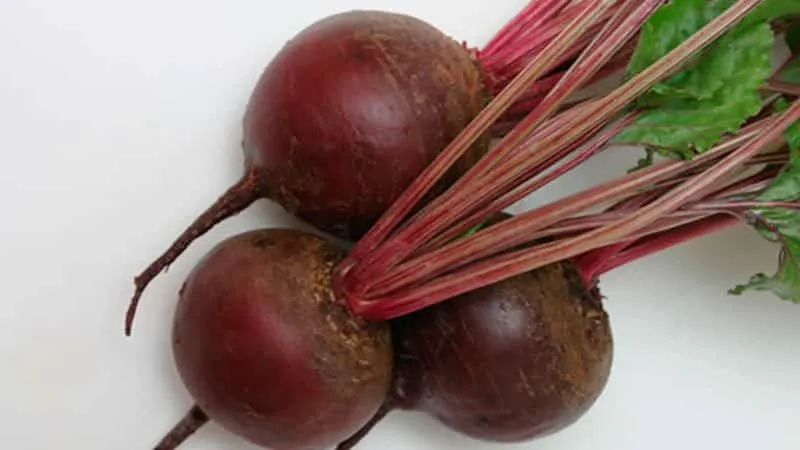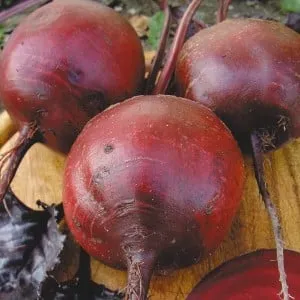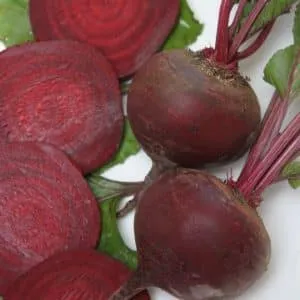The Bordeaux beet variety remains a favorite among gardeners and chefs alike. Gardeners appreciate its ease of cultivation and care, while chefs love its juicy, mildly sweet flesh and vibrant color, which remains unchanged even after cooking.
Table of contents
Description of the Variety
The Bordeaux beet is a mid-season table variety. It thrives across various European climates, tolerating both high and low temperatures. It requires minimal care and stores exceptionally well during winter.
Subvariety Bordeaux 237
The Bordeaux 237 cultivar (a subtype of the Bordeaux variety) was developed by European agronomists during the mid-20th century. In times of food scarcity, a high-yield variety was needed, and Bordeaux 237 can produce two harvests per year.

Origin and Development
The ancestor of the Bordeaux beet was introduced to Europe in the early 20th century.
After selective breeding, two varieties were developed: Bordeaux monogerm and Bordeaux 237.
Distinctive Features
The Bordeaux variety stands out for its deep burgundy color, which inspired its name. This color remains vibrant even after boiling. The moderate size of the roots allows them to be baked whole.
Both the roots and the leaves of the plant are edible (great for salads, soups, and pickling).
Note! The Bordeaux variety is disease-resistant and rarely affected by pests. It has nearly 100% germination rates and can even tolerate mild drought.
Fruit Characteristics and Yield
The roots are round, reaching 10–15 cm in diameter and weighing 350–500 g. The skin is dense and matte.
The flesh is deep red, juicy, firm, and slightly sweet. When cut, it appears uniform or slightly striped.
With proper cultivation and care, you can harvest up to 8 kg of beets per square meter.
How to Grow
Let’s explore the key aspects of beet cultivation.
Planting Seeds or Seedlings
Beet seeds are relatively large compared to other vegetables. They are planted in prepared furrows, spaced about 5 cm apart.
Seeds can be sown either dry or pre-soaked in a growth stimulant solution.
For seedling cultivation, seeds are sown in trays in April. This method allows harvesting almost 20 days earlier than direct sowing. When seedlings develop 2–3 true leaves (usually by mid-May, when soil temperatures reach +10 °C), they can be transplanted.
The Bordeaux 237 variety can also be planted in late autumn: seeds are sown before the first frost and mulched. This yields an early harvest, though storage life is shorter.
Care
To grow large, juicy roots, regular watering is essential. Young beets are watered once a week in the evening, followed by morning soil loosening to prevent crust formation. Mature plants require less frequent watering.
Mulching around the plants reduces the need for frequent weeding and watering.
Young seedlings need regular weeding, as weeds compete for nutrients and may cause diseases.
Fertilization is crucial for healthy root development. Early in the season, nitrogen supports growth, while later, phosphorus, potassium, and boron promote root formation.
Tip! Beets also respond well to foliar feeding.
If your soil is poor, enrich it with nutrients. However, excessive minerals can harm the roots, causing cracking or hollow centers.
Beets also tend to accumulate nitrates, which are harmful if consumed in excess. Always follow recommended fertilizer dosages. Reduce watering and feeding as the season ends.
Growing Tips and Potential Challenges
While beet care is straightforward, there are a few key tips.
- Beets prefer sunny locations.

- Avoid planting where brassicas previously grew.
- Best predecessors: tomatoes, onions, garlic, eggplants.
- Beets thrive in light, alkaline soils.
- Experienced gardeners often plant beets alongside cabbage and carrots, as they share similar growing conditions.
- While beets need moisture, waterlogged roots can rot. Ensure proper drainage.
- Space plants adequately to allow proper root development.
Diseases and Pests
The Bordeaux variety is resistant to diseases and pests. However, if signs of Phoma, downy mildew, or powdery mildew appear, treat the plants immediately.
Insects may target the leaves. Natural remedies like onion peel infusion or wood ash can help deter pests.
Harvesting and Usage
Harvest beets in autumn before frost, when leaves begin to wither.
Carefully dig up the roots, remove soil, and trim the foliage. Cut off any growth points to prevent sprouting during storage.
Sort the beets: damaged ones should be used soon, while healthy, medium-sized roots (large ones store poorly) are ideal for long-term storage.
Pros and Cons of the Variety

The Bordeaux beet is beloved by gardeners for its consistent yields, heat and drought tolerance, and excellent storage qualities.
The vibrant, compact roots are juicy and mildly sweet, perfect for roasting or salads.
This variety has almost no drawbacks.
Subvarieties
The Bordeaux variety includes two subtypes: Bordeaux 237 and Bordeaux monogerm. The key difference is that monogerm beets don’t require thinning, as each seed produces a single sprout.
Bordeaux 237, in turn, gave rise to the Incomparable A-463 and Winter A-474 varieties.
The Incomparable variety has a delicate taste and matures quickly (70 days).
Winter beets can be sown in late autumn for an early harvest. They are also resistant to bolting.
Grower Reviews
Here are some testimonials from gardeners who have cultivated the Bordeaux variety.
Marie, 58, Provence: "Our family adores beets. We’ve tried many varieties, but Bordeaux is unmatched. Always abundant and delicious. We even use the leaves in salads and cold soups."
Hans Müller, Bavaria: "I plant Bordeaux beets every year. The flavor is exceptional, and they store well. Yes, they need watering and weeding, but even in dry summers, they thrive. Harvests are always plentiful. I tried saving seeds once—too much hassle. Buying them is easier."
Luca, Tuscany: "We’ve grown beets for years, and Bordeaux is our favorite. Minimal care, just timely watering. The borscht made from these beets is divine! We even enjoy them raw—sliced thinly for a crisp snack."
Conclusion
The Bordeaux beet is an excellent choice for gardeners and cooks. This time-tested variety withstands adverse conditions while delivering beauty, flavor, and nutrition. Easy to grow and versatile in the kitchen, it outshines many other varieties. Happy growing and cooking!







